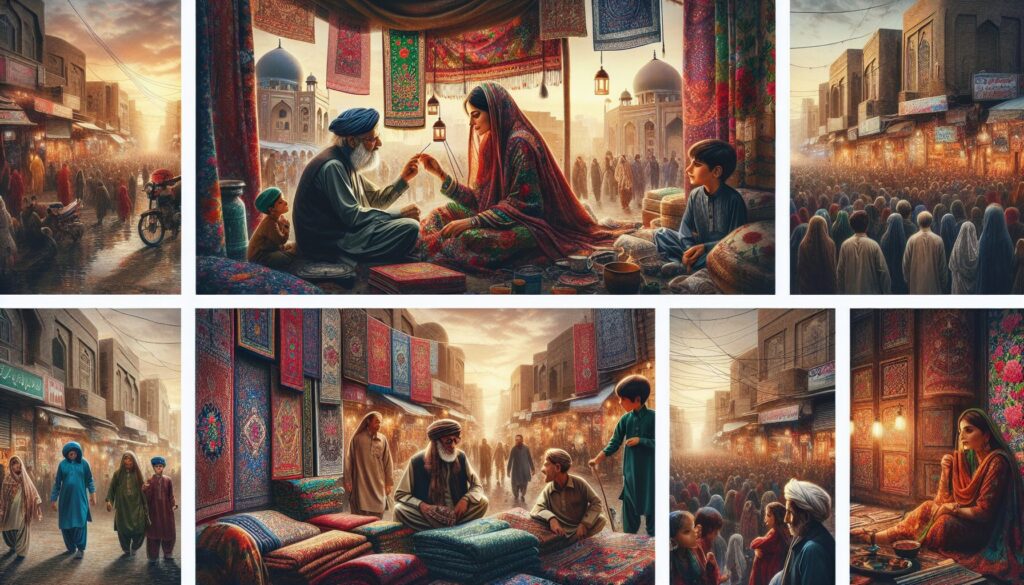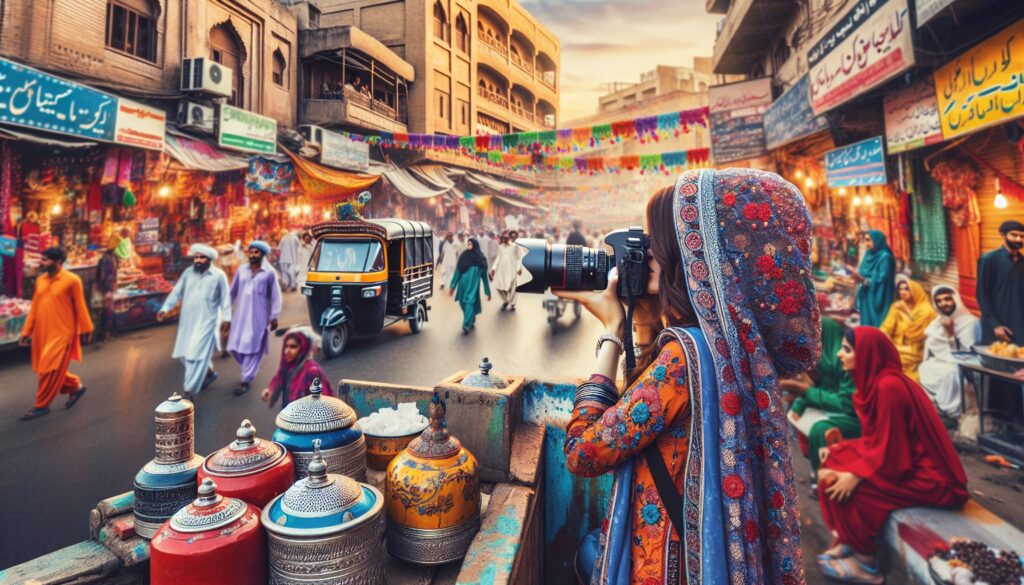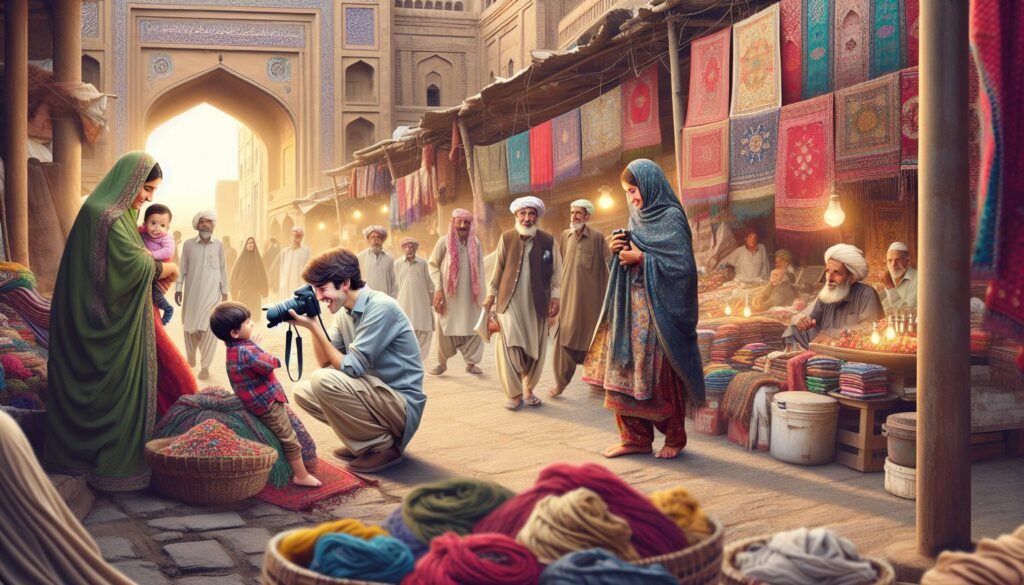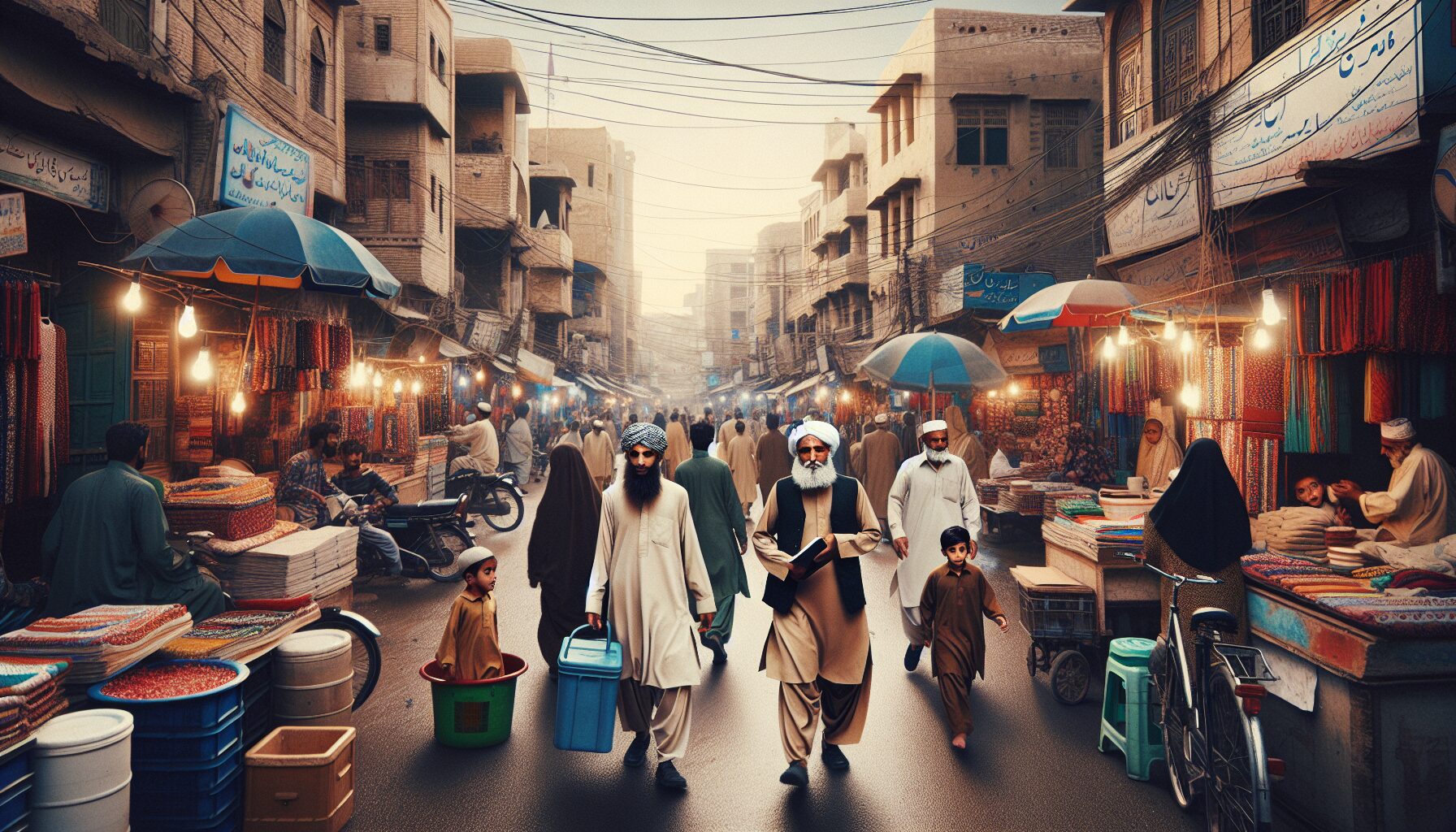Mastering the Art of Street Photography in Pakistan: Unseen Narratives & Techniques begins with exploring the vibrant streets of Lahore and Karachi. I once captured a bustling scene at Lahore’s Anarkali Bazaar, using a wide-angle lens to encompass the lively market atmosphere. The play of light and shadow on Karachi’s Saddar streets at dusk, with a shutter speed of 1/60s, added depth to my photos. For historical context, the winding alleys of Peshawar offer a vintage backdrop, ideal for capturing rich cultural narratives. Dive into the diversity of Pakistani streets, where every corner tells a story. National Geographic
Essential Gear and Settings for Street Photography in Various Pakistani Landscapes
Street photography in Pakistan offers a captivating blend of cultural richness and diverse landscapes. From bustling markets in Lahore to serene, mountainous backdrops in Hunza, each location demands a tailored approach. Here’s how to equip yourself and adjust your settings for the best captures.
Camera and Lenses
Invest in a compact, mirrorless camera for quick, unobtrusive shots. The Fujifilm X100V, with its fixed 23mm lens, is ideal for wide-angle street scenes in crowded bazaars. For more versatility, a 35mm or 50mm lens on a DSLR can capture both wide vistas and intimate portraits.
Settings for Dynamic Environments
In the lively streets of Karachi or Lahore, use a shutter speed of 1/250s or faster to freeze motion. A wide aperture, like f/2.8, helps isolate subjects amidst the chaos. I once captured a rickshaw speeding past a vendor by setting my ISO to 400 and using a shutter speed of 1/500s, ensuring sharpness and clarity.
Capturing Landscapes in Northern Areas
For the serene beauty of Hunza or Skardu, a tripod is essential for long-exposure shots during sunrise or sunset. Use an aperture of f/8 to f/11 for greater depth of field. On a trek through Fairy Meadows, I set my camera to ISO 100 with a shutter speed of 1/15s to capture the soft flow of the river against the sharp peaks, resulting in a dreamy landscape effect.
Accessories for Every Scenario
- Polarizing Filter: Essential for reducing glare and enhancing colors in bright conditions, especially in the mountainous north.
- Extra Batteries and Memory Cards: Essential for long shoots in areas with limited access to electricity.
- Weather Protection: A rain cover for your camera is vital in unpredictable weather, especially during monsoon season.
Always remember to research local customs and ask permission when necessary. Respect for people and places is as crucial as technical skills in mastering the art of street photography in Pakistan. For more insights, explore resources from National Geographic’s photography section https://www.nationalgeographic.com/photography.
Capturing Authentic Narratives: Engaging with Local Communities

Engaging with local communities in Pakistan while mastering the art of street photography can unveil unseen narratives and techniques. Wandering through the bustling streets of Lahore, or the serene alleys of Hunza, provides an opportunity to capture the authenticity of daily life. The key is to immerse yourself in the environment and connect with the people whose stories you wish to tell through your lens.
In Karachi, I once captured the vibrant energy of Empress Market by using a wide-angle lens to include the surrounding chaos. By setting my aperture to f/8, I ensured both the foreground and background were in sharp focus, highlighting the juxtaposition of the seasoned vendors against modern urbanites. This technique allows viewers to appreciate the cultural and historical layers embedded within the scene.
Building Rapport with Subjects
To truly engage with local communities, take time to build rapport. Here are a few tips:
- Learn basic phrases in Urdu or the regional dialect. A simple “Salam” can break the ice.
- Respect privacy and always ask for permission before taking someone’s photograph.
- Share your intention and show previous work if possible. This transparency can foster trust and openness.
Understanding Cultural Context
Understanding the cultural context is crucial in street photography. Pakistan is a mosaic of cultures, and each region has its own unique traditions. For instance, during the Urs festival at the shrine of Lal Shahbaz Qalandar, capturing the Sufi dancers required a high ISO setting due to the low-light conditions. Using a fast shutter speed of 1/250s froze their whirling motions, while still conveying the spiritual intensity of the moment.
According to National Geographic, street photography thrives in environments rich with culture and diversity. Pakistan, with its vibrant street life and hospitable communities, is a perfect canvas for photographers seeking to capture profound human stories.
Techniques for Shooting in Bustling Markets and Quiet Alleys

Wandering through the vibrant markets of Lahore or the serene alleys of Peshawar, street photography in Pakistan offers unique opportunities to capture the essence of life. The bustling bazaars, like Karachi’s Empress Market, are perfect for showcasing the energy and diversity of local culture. To master this art, it’s essential to blend into the environment. Use a prime lens, such as a 35mm or 50mm, which allows for a wider aperture and better performance in low light conditions, common in these crowded settings.
One technique I find invaluable in markets is using a fast shutter speed, around 1/250s, to freeze the chaos of traders haggling and customers bustling. This ensures sharp images even in motion, capturing the vibrancy and activity of Pakistani bazaars. Conversely, in the quiet alleys of Multan’s old city, a slower shutter speed can create a sense of tranquility, allowing the play of shadows and light to narrate a story of solitude and reflection.
Practical Tips for Market Photography
- Engage with Subjects: Building a rapport can lead to more genuine expressions. A simple “Salaam” can open doors to warm interactions.
- Use Natural Light: Early mornings or late afternoons provide soft lighting. In markets, look for stalls that use colorful fabrics as makeshift roofs, casting unique hues on their products.
- Composition: Look for leading lines, such as the rows of stalls or hanging decorations, to draw the viewer’s eye into the scene.
Shooting in Quiet Alleys
- Patience is Key: Unlike markets, alleys require waiting for the right moment, such as when a lone passerby creates a silhouette against the backdrop of historic architecture.
- Soundscapes Matter: The absence of noise can be powerful. Capture the essence of silence by focusing on textures and details, like the peeling paint of old doors or the intricate patterns of mosaic tiles.
- Experiment with Angles: Low angles can highlight the towering nature of alley walls, creating a sense of depth and perspective.
For further insights into the rich cultural tapestry of Pakistan’s streets, consider exploring resources like National Geographic on Pakistan or BBC Travel's Guide to Pakistani Markets. These authoritative sources offer deeper dives into the locales and stories waiting to be captured through your lens.
Overcoming Challenges: Legal and Ethical Considerations in Pakistan

Street photography in Pakistan offers a unique glimpse into the country’s vibrant culture, but it also presents specific legal and ethical challenges that photographers must navigate. Understanding these nuances is essential for anyone aiming to master the art of capturing the streets of Pakistan.
Legal Considerations
Photographers in Pakistan must be aware of local laws concerning privacy and consent. While public spaces are generally open for photography, capturing images of individuals without their permission can lead to legal complications. The Pakistan Penal Code, for instance, has specific sections that protect individuals’ privacy rights. Before taking portraits, especially of women and children, always seek verbal or written consent.
During a recent shoot in Lahore’s bustling Anarkali Bazaar, I encountered a shopkeeper who was uneasy about being photographed. I used a wide-angle lens to incorporate more of the vibrant market scene, which allowed me to capture the essence of the place without focusing solely on any individual. This technique respects privacy while still telling a compelling story.
Ethical Considerations
Ethically, photographers should strive to represent their subjects with dignity and respect. Avoid perpetuating stereotypes or exploiting the image of poverty for artistic gain. Transparency with your subjects about how their images will be used can build trust and foster genuine interactions.
- Always ask: Is this photograph respectful?
- Be mindful of sensitive locations: religious sites like mosques or shrines may have restrictions.
- Engage with subjects: a simple conversation can lead to more authentic captures.
In Karachi’s historic Saddar area, I once captured an elderly man weaving baskets using a 50mm prime lens to achieve a shallow depth of field, emphasizing his skilled hands. Before shooting, I spent time talking to him about his craft, which not only enriched my understanding but also resulted in a photograph that felt both intimate and respectful.
For comprehensive legal guidelines, refer to Pakistan's National Assembly website for the latest legislative updates.
Prominent Pakistani Street Photographers to Follow for Inspiration
Discovering the work of prominent street photographers can be a transformative step in mastering the art of street photography in Pakistan. These photographers not only capture the raw essence of bustling streets but also the myriad emotions that characterize the vibrant culture of the country.
Shahidul Alam
Shahidul Alam’s photography is a window into the vivid tapestry of South Asian life. Known for his bold use of color and contrast, his images provide a profound narrative of everyday life in Pakistan. In one of his iconic shots, Alam used a wide-angle lens to capture the convergence of a crowded Karachi street. The scene was bustling with rickshaws, vendors, and pedestrians, all bathed in the warm glow of the setting sun. This photograph encapsulates the spirit of a city always on the move. You can explore more of his work on Wikipedia https://en.wikipedia.org/wiki/Shahidul_Alam.
Sara Farid
Sara Farid’s lens captures the intricate dance of light and shadow in Pakistani urban landscapes. Her approach often features a shallow depth of field, highlighting her subjects against blurred backgrounds of vibrant city life. During a recent photo walk in Lahore, she utilized a 50mm f/1.8 lens to isolate a street vendor against the backdrop of the historic Walled City. The result was a striking portrait that highlighted the vendor’s weathered face and the rich textures of his merchandise. Her work is featured in major publications like National Geographic https://www.nationalgeographic.com/.
Mobeen Ansari
Mobeen Ansari is renowned for his ability to encapsulate the emotions of diverse communities across Pakistan. His series, focusing on the people of Sindh, employs natural light to enhance the authenticity of his portraits. In one memorable session, Ansari photographed a fisherman at dawn, using a tripod and a slow shutter speed of 1/15s to capture the gentle motion of the water. The resulting image is a serene depiction of life along the Indus River. Discover more about his compelling narratives in reputable sources such as BBC https://www.bbc.com/news.
Following these photographers can provide invaluable insights into the unseen narratives and techniques of street photography in Pakistan.
Conclusion
Street photography in Pakistan offers a vibrant tapestry of colors, emotions, and stories that are waiting to be captured. The bustling streets of Lahore, Karachi, and Islamabad provide a unique canvas for photographers to capture the essence of daily life and cultural richness. The narrow alleys of old Lahore, for instance, present an opportunity to use a wide-angle lens to encapsulate the intricate blend of Mughal architecture and modern life. By setting your aperture to f/8, you can ensure the depth of field needed to capture both the foreground and background in sharp detail.
Key Techniques for Capturing Unseen Narratives
To capture the dynamic atmosphere of a bustling bazaar, consider employing a slow shutter speed, such as 1/15s, to blur the motion of traders and buyers, creating a sense of movement and chaos. Early mornings or late afternoons provide the best lighting conditions, where the soft, diffused light enhances the textures and shadows of the scene.
When photographing people, engage with your subjects to capture genuine emotions. A simple smile or greeting in Urdu can break the ice and make your subjects feel comfortable. Using a 50mm prime lens allows for a natural perspective, bringing you closer to the subject without distortion, making it ideal for portrait shots that capture the soul of the person.
Resource Recommendations
To deepen your understanding of street photography in Pakistan, consider exploring resources from major publications like National Geographic for insights into cultural contexts or BBC for stories that highlight Pakistan’s diverse society.
Engaging with the Community
Joining local photography groups can be invaluable. These communities, often found on platforms like Facebook or Instagram, offer support, feedback, and opportunities to participate in photo walks and exhibitions. Engaging with fellow photographers will not only refine your skills but also enrich your understanding of Pakistan’s diverse narratives.
Ultimately, mastering street photography in Pakistan is about patience, respect, and an eye for detail. With every click, you have the chance to capture a slice of life that tells an unseen story, resonating with viewers both locally and globally.
Continue Exploring
Dive into the mesmerizing world beneath Pakistan's waves and capture breathtaking images of its unique marine life. Elevate your photography skills with tips from experts and uncover the secrets of underwater photography!
Frequently Asked Questions
What are the best cities in Pakistan for capturing street photography that showcases its rich culture and emotions?
Some of the best cities in Pakistan for street photography include Lahore, Karachi, and Islamabad. Lahore is known for its vibrant street life and historic sites, while Karachi offers a diverse mix of urban landscapes and cultural diversity. Islamabad, with its modern architecture and scenic beauty, provides a unique backdrop. Each city offers distinct opportunities to capture the rich culture and emotions of Pakistan.
How can I approach locals in Pakistan for street photography without intruding on their personal space?
Approaching locals for street photography in Pakistan requires sensitivity and respect. Always seek permission before taking someone’s photograph, and be polite and patient. Learning a few basic phrases in Urdu can help break the ice and show respect. It’s also helpful to explain your project or intention, which can make people more comfortable and willing to participate.
What are some essential techniques for mastering street photography in Pakistan's bustling environments?
To master street photography in Pakistan, focus on techniques like capturing candid moments, using natural light effectively, and composing dynamic shots. Familiarize yourself with local customs and be mindful of your surroundings to capture authentic street scenes. Additionally, use fast shutter speeds to freeze action in busy markets and streets, and consider experimenting with different angles to add depth to your photos.


Leave a Reply